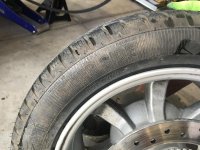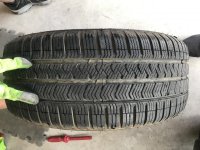I think the notion that if the tyre aquaplanes there may be an issue is a misunderstanding of aquaplaning. In this situation the tyre will have completely left the road surface and it will be on top of the water. For all intents, there will be almost zero drag and zero friction; imagine the bottom of the water layer being on the road and the tyre on the top of the water layer then the only grip is water on water so very little friction or drag.
Asymmetric treads are used for a number of reasons, one is; since the outer edge of the tyre carries higher load when cornering a more suitable tread pattern can be present at the outer side to better deal with that load. Secondly, the unequal drag will cause the tyre to attempt to turn and this loads up the steering so a steering input from the driver gets a faster response from the tyre, obviously two tyres are necessary for this so it plainly lends itself particularly to front wheel application. Thirdly, some asymmetric tyres actually have asymmetric construction under the tread to impart better handling and steering response.
Plainly a single asymmetric tyre is going to try to make a turn but whether this offset force will be noticeable to a rider when it is applied so close to the centreline of a bike is up for debate. Perhaps on a smooth, level surface it may be but on most road surfaces I suspect it will be lost in the forces caused by the general road surface imperfections. imho, of course.
Overall agree, and based on your words, would you consider the difference in performance critical for the single rear tire?
A while back, a friend purchased a new rear tire that I helped him mount and balance. The tire he purchased was labeled for placing one side of the tires tread pattern to the outside. Being a single rear tire, we obviously had one of the tires sidewalls outside as recommended, and the side that should have been inside became an outside also. Any specific thoughts beyond your post regarding this.
A very long while back, several of us here discussed these concerns. It was agreed by some of us, myself included, to utilize a tire that could be rotationally directional, but having tread symmetry that was mirrored on each side of the tires rotational centerline.
At the time, it was common to run the Yokohama s.Drive on the rear. Back then, General offered, but has since discontinued the Altimax RT HP, which had mirrored tread also. There have been a few other tire brands / models that have come and gone that also had balanced tread symmetry.
I have always been very skeptical about the use of tire tests posted here on SL. For those tests, that are fair when comparing similar intended uses against similar intended use, say touring vs touring, there is no true way to compare a touring tire against say a performance tire. A lower rated performance tire could easily outperform the best touring tire, but the test comparison numbers by say Tire Rack will not indicate this.
Add in, that many people do not understand the true meanings of the tire sidewall ratings adds further confusion. Treadwear, Traction and Temp, are not all in regards to a tire running in dry conditions. Is it better to have a treadwear value twice the average thinking you will get more miles per dollar. I suspect most high treadwear tires will be aged out before worn out, while compromising grip in dry conditions. The traction ratings, based on wet grip, are less important if you never ride in the rain.
Is tire symmetry super critical. It could be. Like anything you drive, as you push the performance envelope, you may need a higher performance tire and tread design may be a factor of that.


